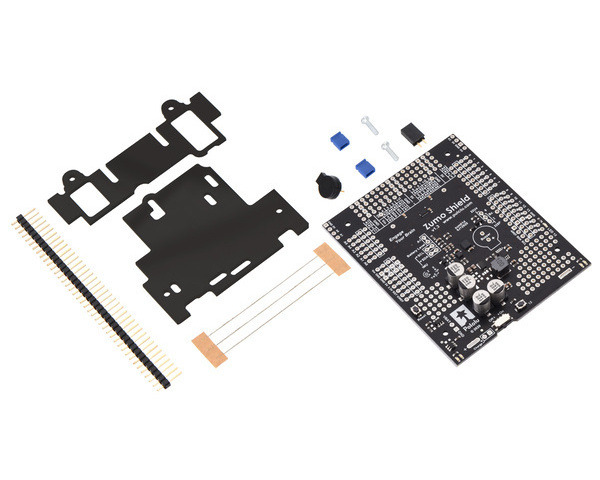

This is a merged information page for Item #2521.
View normal product page.
Pololu item #:
2521
Brand:
Pololu
Status:
Active

This shield makes it easy to build an Arduino-controlled Zumo robot. The shield mounts onto an assembled Zumo chassis, connecting directly to the chassis’s battery terminals and motors, and the Arduino plugs into the shield, face down. This shield includes dual motor drivers, a buzzer for playing simple sounds and music, a user pushbutton, and a 3-axis accelerometer, compass, and gyroscope. The shield boosts the battery voltage to power the Arduino, and it breaks out the Arduino I/O lines, reset button, and user LED for convenient access and to accommodate additional sensors for things like obstacle and edge detection.
 Compare all products in Zumo Robot for Arduino or
Compare all products in Zumo Robot for Arduino or  Shields for Arduino.
Shields for Arduino.
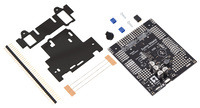 |
Zumo Shield for Arduino, v1.3, shown with included hardware. |
|---|
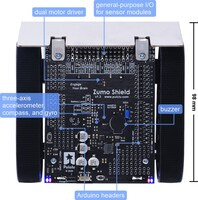 |
Main features of the Zumo Shield for Arduino, v1.3. |
|---|
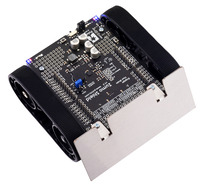 |
Zumo Robot for Arduino. |
|---|
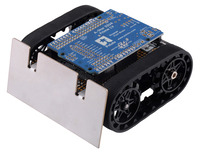 |
Assembled Zumo Robot for Arduino with an Arduino-compatible A-Star 32U4 Prime LV. |
|---|
 |
Zumo Shield for Arduino, v1.3, as it ships (assembled with surface-mount components only). |
|---|
 |
Zumo Shield for Arduino, v1.3, with included through-hole components installed. |
|---|
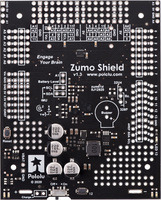 |
Zumo Shield for Arduino, v1.3, as it ships (assembled with surface-mount components only). |
|---|
 |
Zumo Shield for Arduino, v1.3, with included through-hole components installed. |
|---|
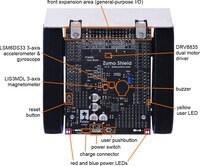 |
Assembled Zumo Robot for Arduino, top view with labeled components. |
|---|
 |
Assembled Zumo Robot for Arduino with an Arduino Uno, back view. |
|---|
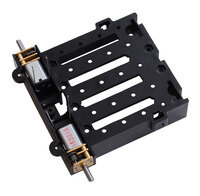 |
Zumo chassis being assembled with two Micro Metal Gearmotor. |
|---|
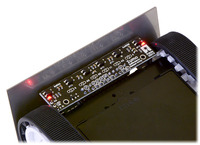 |
Zumo reflectance sensor array on a Zumo robot, bottom view. |
|---|
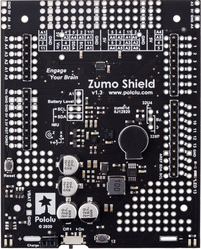 |
Zumo Shield for Arduino, v1.3, with included through-hole components installed. |
|---|
The Zumo Shield is designed specifically to be a convenient interface between a Zumo chassis and an A-Star 32U4 Prime, Arduino Uno, or Arduino Leonardo. The shield mounts directly to the chassis, connecting to its battery terminals and motors, and the A-Star Prime or Arduino plugs into the shield’s male header pins, face down. The shield provides all the electronics necessary to power the motors and includes some additional fun components for making a more interesting robot, such as a buzzer for making sounds, and a 3-axis accelerometer, compass, and gyroscope for sensing impacts and tracking orientation.
With the Zumo Shield and an Arduino (or compatible board like the A-Star Prime), the Zumo chassis becomes a low-profile, Arduino-controlled tracked robot that is less than 10 cm on each side (small enough to qualify for Mini-Sumo competitions). It works with a variety of micro metal gearmotors to allow for a customizable combination of torque and speed, and a stainless steel sumo blade is available for applications that involve pushing around other objects. Arduino libraries and sample sketches are available for quickly getting a Zumo robot up and running.
|
|
This shield is also available as part of our Zumo Robot kit for Arduino, which bundles it with a Zumo chassis and Zumo blade, and in our Zumo Robot for Arduino, which is preassembled with 75:1 HP micro metal gearmotors and a Zumo reflectance sensor array.
This is the v1.3 version of the Zumo Shield. It uses an LSM6DS33 accelerometer and gyro and an LIS3MDL magnetometer, replacing the LSM303D and L3GD20H sensors on the previous v1.2 revision. You can use our updated Zumo Shield Arduino library to help you write code that will work with the inertial sensors on any revision.
In addition, the power switch and pushbuttons on the v1.3 shield are surface-mount components instead of through-hole parts like those on the v1.2 version.
For more information, see the user’s guide.
 |
The Zumo Shield ships with all of the components required for shield assembly, as shown in the main product picture. Note that soldering is required; please see the user’s guide for detailed assembly instructions. This shield does not include motors or the Zumo chassis itself, though it is available as part of a Zumo Robot kit for Arduino that includes everything you need to build your Zumo robot except motors, an Arduino, and batteries. If you just want a robot that is already put together, we also sell a fully assembled Zumo Robot for Arduino – just add batteries and an Arduino or A-Star Prime and it is ready to go.
 |
Zumo chassis being assembled with two Micro Metal Gearmotor. |
|---|
To use this shield you will need a few additional parts:
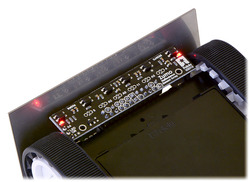 |
Zumo reflectance sensor array on a Zumo robot, bottom view. |
|---|
The newer Zumo 32U4 is another robot based on the Zumo chassis. It is a more highly integrated robot than the Zumo robot for Arduino, with enhancements that include a built-in Arduino-compatible ATmega32U4 microcontroller (the same one used in the Arduino Leonardo and A-Star 32U4 boards), an LCD, encoders for closed-loop motor control, and proximity sensors for obstacle detection. The Zumo 32U4 main board effectively combines the functions of the Zumo Shield and the separate Arduino controller into a single, compact board that is just as easy to program as a standard Arduino or A-Star thanks to its USB interface and preloaded Arduino-compatible bootloader.
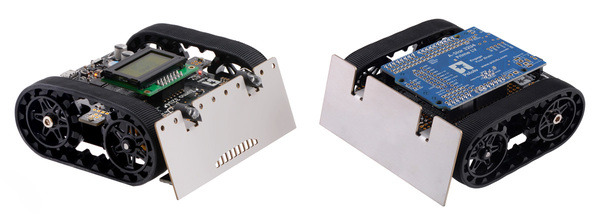 |
A Zumo 32U4 robot (left) and a Zumo robot for Arduino with an A-Star 32U4 Prime LV (right). |
|---|
Some of the pin mappings and software libraries differ between the Zumo 32U4 and Zumo robot for Arduino, so programs written for one robot generally need to be modified to work on the other.
| PCB dev codes: | zum01d |
|---|---|
| Other PCB markings: | 0J12920 |
User’s manual for the Pololu Zumo Shield for Arduino.
This DXF drawing shows the locations of all of the board’s holes.
Un guide complet pour assembler, utiliser et exploiter rapidement votre Robot Zumo (version 0.1). Note: This French translation of our Zumo Robot for Arduino user’s guide was made by our distributor MCHobby.
This library and examples for Arduino-compatible boards makes it easy to program an Arduino-controlled robot built with Pololu’s Zumo Shield or Zumo robot kit (also available fully assembled).
This library can be used to program an Arduino-controlled Zumo through MATLAB and Simulink. It provides driver blocks for all the sensors present on the Zumo Robot as well as example models showing their usage.
This tutorial on the Adafruit Learning System guides you through the process of programming a Zumo robot with Simulink.
This MicroPython library from Pololu distributor MC Hobby allows a MicroPython pyboard or Raspberry Pi Pico to control a Zumo Robot for Arduino. MC Hobby has adapter boards that let you easily connect either controller to the Zumo Shield. Documentation is available in both French and English.
This tutorial from Adafruit shows how to pair a Pixy CMUCam-5 vision system with the Zumo Robot for Arduino to enable it to chase objects or follow you around.
This article was written by Professor Erich Styger for his class on embedded systems programming at the Lucerne University of Applied Sciences and Arts. It describes various ways to tweak the performance of a Zumo to be more competitive in a Mini Sumo competition. Note that his Zumos use a custom PCB rather than our Zumo shield for Arduino; our shield has a lot of capacitance in parallel with the batteries that generally prevents the “battery inertia” problem Erich describes.
This robot is uses our Zumo robot kit, 75:1 micro metal gearmotors, and a Zumo reflectance sensor array. Instead of an Arduino it uses a Freescale FRDM-KL25Z as the microcontroller board, and sample code is available for line following and maze solving. By Erich, March 2013.
No FAQs available.
No blog posts to show.